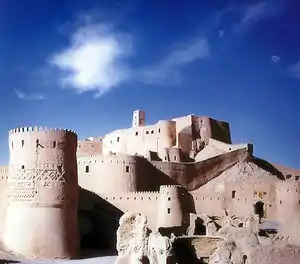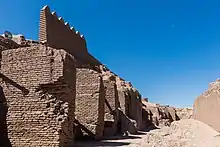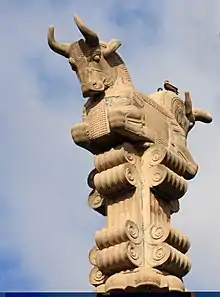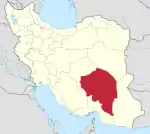Bam, Iran
Bam[2] (Persian: بم) is a city and capital of Bam County, Kerman Province, Iran. At the 2006 census, its population was 73,823, in 19,572 families.[3]
Bam
بم | |
|---|---|
City | |
))_-_panoramio.jpg.webp) Bam in 2013 | |
 Bam | |
| Coordinates: 29°06′22″N 58°21′25″E | |
| Country | |
| Province | Kerman |
| County | Bam |
| Bakhsh | Central |
| Elevation | 1,061 m (3,481 ft) |
| Population (2016 Census) | |
| • Urban | 127,396 [1] |
| Time zone | UTC+3:30 (IRST) |
| • Summer (DST) | UTC+4:30 (IRDT) |
| Official name | Bam and its Cultural Landscape |
| Criteria | Cultural: ii, iii, iv, v |
| Reference | 1208 |
| Inscription | 2004 (28th session) |
| Endangered | 2004-2013 |
The modern Iranian city of Bam surrounds the Bam citadel. Before the 2003 earthquake the official population count of the city was roughly 43,000.[4] There are various opinions about the date and reasons for the foundation of the citadel. Economically and commercially, Bam occupied a very important place in the region and was famous for its textiles and clothes. Ibn Hawqal (943–977), the Arab traveller and geographer, wrote of Bam in his book Surat-ul-`ard (The Earth-figure):
- Over there they weave excellent, beautiful and long-lasting cotton cloths which are sent to places all over the world There they also make excellent clothes, each of which costs around 30 dinars; these are sold in Khorasan, Iraq and Egypt.
The ancient citadel of Arg-é Bam has a history dating back around 2,000 years ago, to the Parthian Empire (248 BC–224 AD), but most buildings were built during the Safavid dynasty. The city was largely abandoned due to an Afghan invasion in 1722. Subsequently, after the city had gradually been re-settled, it was abandoned a second time due to an attack by invaders from Shiraz. It was also used for a time as an army barracks.
The modern city of Bam has gradually developed as an agricultural and industrial centre, and until the 2003 earthquake was experiencing rapid growth. In particular, the city is known for its dates and citrus fruit, irrigated by a substantial network of qanats. The city also benefited from tourism, with an increasing number of people visiting the ancient citadel in recent years.
The earthquake destroyed and damaged much of the city and killed a large part of the population. Since then, Bam has been in recovery.
2003 earthquake


The 2003 Bam earthquake struck Bam and the surrounding Kerman province of south-eastern Iran at 01:56 UTC (5:26 AM Iran Standard Time) on 26 December 2003. The most widely accepted estimate for the magnitude of the earthquake is 6.6 on the moment magnitude scale (Mw); estimated by the United States Geological Survey. The earthquake was particularly destructive, with the death toll amounting to 26,271 people and injuring an additional 30,000. The effects of the earthquake and damage was exacerbated by the fact that the city chiefly consisted of mud brick buildings, many of which did not comply with earthquake regulations set in Iran in 1989, and that most of the city's people were indoors and asleep.
Due to the earthquake, relations between the United States and Iran thawed. Following the earthquake the U.S. offered direct humanitarian assistance to Iran and in return the state promised to comply with an agreement with the International Atomic Energy Agency which supports greater monitoring of its nuclear interests. In total a reported 44 countries sent in personnel to assist in relief operations and 60 countries offered assistance and support.
Post-2003 development
Immediately following the 2003 earthquake, the Iranian government began to plan a new city based on population control theories in order to eliminate problems that existed with the old city. The development of the plan took at least six months and resulted in significant complaints against the central government and local government by the Bam earthquake survivors.[5] Nevertheless, government in Tehran continued its plans and currently the city is being rebuilt. The citadel is also being rebuilt with specialist care from the Ministry of Culture and from Japanese universities. The earthquake was an extreme tragedy and stunted the growth of Bam as a city, especially as about half of the city's residents were killed and most of the remainder hurt.[6] Costs of the earthquake mounted to between $700 million and $1 billion U.S. dollars.
Climate
Bam has a desert climate (Köppen climate classification BWh) with long, hot summers and mild, short winters. The average annual rainfall is around 60 mm.
| Climate data for Bam 1067m (1956–2010) | |||||||||||||
|---|---|---|---|---|---|---|---|---|---|---|---|---|---|
| Month | Jan | Feb | Mar | Apr | May | Jun | Jul | Aug | Sep | Oct | Nov | Dec | Year |
| Record high °C (°F) | 30.0 (86.0) |
33.2 (91.8) |
38.0 (100.4) |
39.6 (103.3) |
44.6 (112.3) |
47.6 (117.7) |
46.6 (115.9) |
47.0 (116.6) |
43.6 (110.5) |
40.0 (104.0) |
34.2 (93.6) |
32.0 (89.6) |
47.6 (117.7) |
| Average high °C (°F) | 16.5 (61.7) |
19.7 (67.5) |
24.7 (76.5) |
30.2 (86.4) |
35.3 (95.5) |
39.2 (102.6) |
39.6 (103.3) |
38.2 (100.8) |
35.4 (95.7) |
30.6 (87.1) |
23.8 (74.8) |
18.4 (65.1) |
29.3 (84.7) |
| Daily mean °C (°F) | 10.7 (51.3) |
13.6 (56.5) |
18.5 (65.3) |
23.8 (74.8) |
28.8 (83.8) |
32.8 (91.0) |
33.6 (92.5) |
32.0 (89.6) |
28.9 (84.0) |
24.0 (75.2) |
17.5 (63.5) |
12.4 (54.3) |
23.0 (73.4) |
| Average low °C (°F) | 4.8 (40.6) |
7.6 (45.7) |
12.3 (54.1) |
17.4 (63.3) |
22.4 (72.3) |
26.4 (79.5) |
27.6 (81.7) |
25.8 (78.4) |
22.3 (72.1) |
17.4 (63.3) |
11.2 (52.2) |
6.4 (43.5) |
16.8 (62.2) |
| Record low °C (°F) | −9.0 (15.8) |
−5.0 (23.0) |
−3.0 (26.6) |
4.0 (39.2) |
9.5 (49.1) |
18.0 (64.4) |
19.0 (66.2) |
15.0 (59.0) |
11.0 (51.8) |
6.0 (42.8) |
−2.0 (28.4) |
−7.0 (19.4) |
−9.0 (15.8) |
| Average precipitation mm (inches) | 12.0 (0.47) |
8.9 (0.35) |
12.2 (0.48) |
9.7 (0.38) |
5.5 (0.22) |
0.6 (0.02) |
0.9 (0.04) |
0.6 (0.02) |
0.2 (0.01) |
0.9 (0.04) |
2.2 (0.09) |
5.1 (0.20) |
58.8 (2.31) |
| Average precipitation days (≥ 1.0 mm) | 2.1 | 1.8 | 2.7 | 2.3 | 1.1 | 0.2 | 0.1 | 0.1 | 0.1 | 0.4 | 0.6 | 1.2 | 12.7 |
| Average snowy days | 0.4 | 0.1 | 0.0 | 0.0 | 0.0 | 0.0 | 0.0 | 0.0 | 0.0 | 0.0 | 0.0 | 0.2 | 0.7 |
| Average relative humidity (%) | 46 | 41 | 36 | 31 | 26 | 21 | 21 | 21 | 22 | 27 | 34 | 42 | 30 |
| Mean monthly sunshine hours | 234.1 | 223.8 | 239.5 | 258.3 | 311.2 | 331.4 | 338.4 | 336.8 | 306.6 | 296.8 | 260.4 | 240.2 | 3,377.5 |
| Source: Iran Meteorological Organization (records),[7] (temperatures),[8] (precipitation),[9] (humidity),[10] (days with precipitation),[11] | |||||||||||||
On 16 March 2007 a 130 km/h (81 mph) sandstorm hit the city of Bam without warning, suffocating 3 children, killing 2 in car accidents, and wounding 14 others.[14]
References
- https://www.amar.org.ir/english
- Bam, Iran can be found at GEOnet Names Server, at this link, by opening the Advanced Search box, entering "-3055036" in the "Unique Feature Id" form, and clicking on "Search Database".
- "Census of the Islamic Republic of Iran, 1385 (2006)". Islamic Republic of Iran. Archived from the original (Excel) on 11 November 2011.
- "Cold is the main health threat after the Bam earthquake". BMJ. Retrieved 13 September 2007.
- "Hamshahri Newspaper". Hamshahrionline.ir. Retrieved 21 August 2010.
- "Iran, Iranian, Nuclear, political, Natural, Sports, Cultural, economic, SocialAndOccations news and headlines". Mehr News Agency. Retrieved 21 August 2010.
-
- "Highest record temperature in Bam by Month 1956–2010". Iran Meteorological Organization. Retrieved 8 April 2015.
- "Lowest record temperature in Bam by Month 1956–2010". Iran Meteorological Organization. Retrieved 8 April 2015.
-
- "Average Maximum temperature in Bam by Month 1956–2010". Iran Meteorological Organization. Archived from the original on 10 March 2016. Retrieved 8 April 2015.
- "Average Mean Daily temperature in Bam by Month 1951–2010". Iran Meteorological Organization. Retrieved 8 April 2015.
- "Average Minimum temperature in Bam by Month 1956–2010". Iran Meteorological Organization. Archived from the original on 10 March 2016. Retrieved 8 April 2015.
- "Monthly Total Precipitation in Bam by Month 1956–2010". Iran Meteorological Organization. Retrieved 8 April 2015.
- "Average relative humidity in Bam by Month 1956–2010". Iran Meteorological Organization. Archived from the original on 10 March 2016. Retrieved 8 April 2015.
- "No. Of days with precipitation equal to or greater than 1 mm in Bam by Month 1956–2010". Iran Meteorological Organization. Archived from the original on 10 March 2016. Retrieved 8 April 2015.
- "No. Of days with snow in Bam by Month 1956–2010". Iran Meteorological Organization. Archived from the original on 10 March 2016. Retrieved 8 April 2015.
- "Monthly total sunshine hours in Bam by Month 1956–2010". Iran Meteorological Organization. Archived from the original on 10 March 2016. Retrieved 8 April 2015.
- "5 Killed In Bam Sandstorm". Irib Persian News Page through The Internet Archive. Archived from the original on 27 September 2007. Retrieved 26 January 2010.
External links
| Wikimedia Commons has media related to Bam, Iran. |
| Wikivoyage has a travel guide for Bam. |
| Wikisource has the text of the 1911 Encyclopædia Britannica article Bam. |
- Travel magazine story on Bam as a tourist destination
- Newspaper item: "The Lost Beauty that was Bam"
- BBC story: "Bam: Jewel of Iranian heritage"
- Population figures from World-Gazetteer.com
- Digital Silk Roads Project – Citadel of Bam. Photos and movies
- To Bam & back by Asghar Riahi
2003 earthquake
Earthquake reconstruction
- Reconstruction efforts in quake-devastated Bam continue two years on
- Bam: Five Years After
- Arg-e Bam – The BAM Citadel – Film Documentary:
- Arg e Bam Movie Documentary – The BAM Citadel

